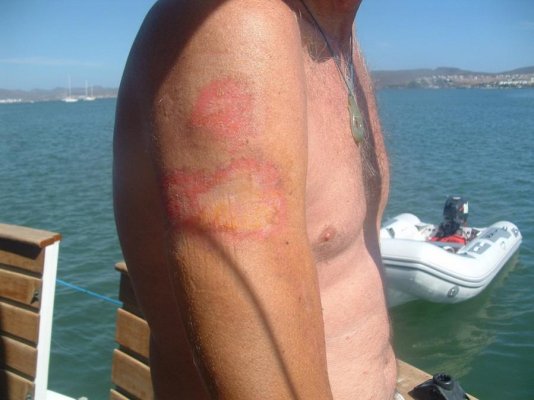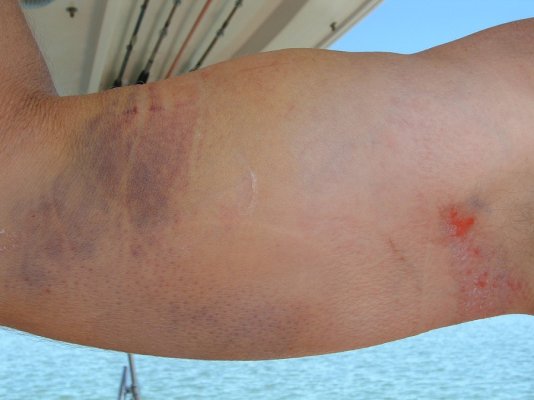tedted
Veteran Member
- Joined
- Feb 27, 2016
- Messages
- 54
- Location
- USA
- Vessel Name
- Castoff
- Vessel Make
- 77 Heritage West Indian 36
Greetings, When I pulled our boat this fall I checked the cutlass bearing for wear. Although it felt great, I noticed that there was a polish mark forward of the bearing indicating that the shaft is moving fore and aft in the bearing.
It appears to be about 5/8 of an inch. The boat is new to us this year and I am still new to higher HP applications, but this seems to be excessive. While chasing other problems, I've run the engine at full load in both forward and reverse. So I'm not surprised to see shifting, just not this much. The engine was replaced a while back before we had it. The original was a Perkins 6.354, 135 hp. It was replaced with a Perkins T6.354.4 turbo 240hp (I wish it was the 135). The transmission is a Velvet Drive 2.1 to1 ratio.
My first suspicion is shifting in the engine mounts. Secondly, lash in the transmission. Either one is not good. The engine sets in a formidable steel welded cradle bolted to the stringers. Actually I was pretty impressed with the installation. So I don't expect movement there.
There is absolutely no vibration or noise until I reach 2,200 rpm and then there is a rumbling and lots of other noises that I attribute to the boat trying to go on plane and pushing a huge bow wake. I wonder too if doubling the hp is the cause of the noise and shifting by exceeding the limits of the previous engine installation. In which case just don't throttle up max. Our Heritage West Indian 36 tops out at close to 12kts with the new engine.
Looking around the yard I see other inboard boats with this shifting but not as pronounced. Any Ideas? Thanks, Ted
It appears to be about 5/8 of an inch. The boat is new to us this year and I am still new to higher HP applications, but this seems to be excessive. While chasing other problems, I've run the engine at full load in both forward and reverse. So I'm not surprised to see shifting, just not this much. The engine was replaced a while back before we had it. The original was a Perkins 6.354, 135 hp. It was replaced with a Perkins T6.354.4 turbo 240hp (I wish it was the 135). The transmission is a Velvet Drive 2.1 to1 ratio.
My first suspicion is shifting in the engine mounts. Secondly, lash in the transmission. Either one is not good. The engine sets in a formidable steel welded cradle bolted to the stringers. Actually I was pretty impressed with the installation. So I don't expect movement there.
There is absolutely no vibration or noise until I reach 2,200 rpm and then there is a rumbling and lots of other noises that I attribute to the boat trying to go on plane and pushing a huge bow wake. I wonder too if doubling the hp is the cause of the noise and shifting by exceeding the limits of the previous engine installation. In which case just don't throttle up max. Our Heritage West Indian 36 tops out at close to 12kts with the new engine.
Looking around the yard I see other inboard boats with this shifting but not as pronounced. Any Ideas? Thanks, Ted



